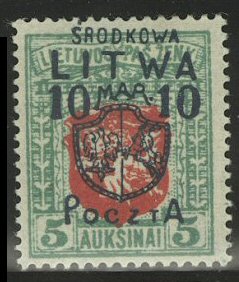
Return To Catalogue - Lithuania
Note: on my website many of the
pictures can not be seen! They are of course present in the cd's;
contact me if you want to purchase them: evert@klaseboer.com.
2 m on 15 s lilac 4 m (blue) on 10 s red 4 m on 20 s blue 4 m (blue) on 30 s brown 6 m (blue) on 50 s green 6 m (blue) on 60 s violet and red 6 m on 75 s brown and red 10 m (blue) on 1 A grey and red 10 m on 3 A brown and red 10 m on 5 A green and red
Value of the stamps |
|||
vc = very common c = common * = not so common ** = uncommon |
*** = very uncommon R = rare RR = very rare RRR = extremely rare |
||
| Value | Unused | Used | Remarks |
| 2 m on 15 s | *** | *** | |
| 4 m on 10 s | ** | ** | |
| 4 m on 20 s | *** | *** | |
| 4 m on 30 s | ** | ** | |
| 6 m on 50 s | *** | *** | |
| 6 m on 60 s | *** | *** | |
| 6 m on 75 s | *** | *** | |
| 10 m on 1 A | *** | *** | |
| 10 m on 3 A | RR | RR | |
| 10 m on 5 A | RR | RR | |
From 1920 to 1922 Central Lithuania issued its own stamps, they all have the inscription Litwa Srodkowa. In 1922 Central Lithuania was unified with Poland. Examples:
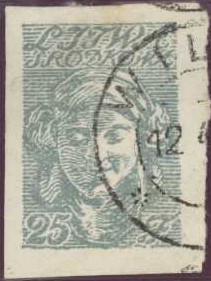
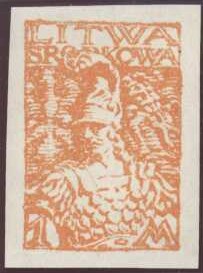


25 f grey (woman's head) 1 M orange (man with harnass) 2 M lilac (building) 4 M green and yellow (building) 6 M red and grey (swords?) 10 M brown and yellow (general Zeligowski)
Value of the stamps |
|||
vc = very common c = common * = not so common ** = uncommon |
*** = very uncommon R = rare RR = very rare RRR = extremely rare |
||
| Value | Unused | Used | Remarks |
| 25 f to 2 M | c | c | |
| 4 M and 6 M | c | * | |
| 10 M | * | * | |
Surcharged

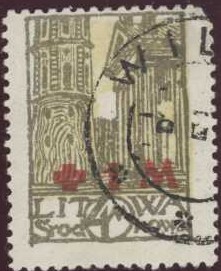
'+1' on 2 M lilac '+1M' on 4 M green and yellow
Value of the stamps |
|||
vc = very common c = common * = not so common ** = uncommon |
*** = very uncommon R = rare RR = very rare RRR = extremely rare |
||
| Value | Unused | Used | Remarks |
| '+1' on 2 M | c | * | |
| '+1M' on 4 M | * | * | |
Similar design, but with surcharge incorporated in the design
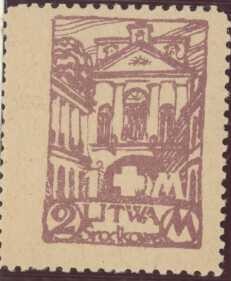


2 M + 1 M lilac 4 M + 1 M green and yellow 10 M + 2 M brown and yellow
Value of the stamps |
|||
vc = very common c = common * = not so common ** = uncommon |
*** = very uncommon R = rare RR = very rare RRR = extremely rare |
||
| Value | Unused | Used | Remarks |
| 2 M + 1 M | c | * | |
| 4 M + 1 M | * | * | |
| 10 M + 2 M | * | * | |
25 f red 25 f green 1 M blue 1 M brown 2 M violet 2 M yellow
Value of the stamps |
|||
vc = very common c = common * = not so common ** = uncommon |
*** = very uncommon R = rare RR = very rare RRR = extremely rare |
||
| Value | Unused | Used | Remarks |
| All values | c | c | |
Overprinted 'NA SLASK 2 M.' (1921)

2 M (green) on 25 f red 2 M (red) on 25 f green 2 M (red) on 1 M blue 2 M (red) on 1 M brown 2 M (red) on 2 M violet 2 M (red) on 2 M yellow
Value of the stamps |
|||
vc = very common c = common * = not so common ** = uncommon |
*** = very uncommon R = rare RR = very rare RRR = extremely rare |
||
| Value | Unused | Used | Remarks |
| All values | c | * | |
Forgeries of these stamps exist. If I'm well informed genuine (perforated) stamps have perforation 11 1/2. Forged stamps have perforation 10 3/4 x 11. Source: http://www.stampcollectingblog.com/srodkowa-litwa-stamps-of-central-lithunia.php

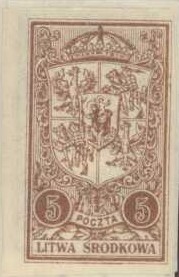
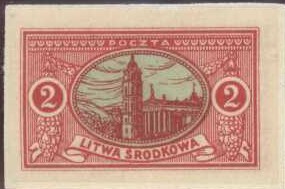
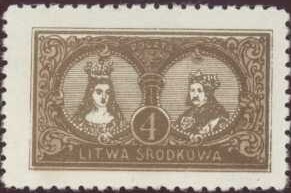

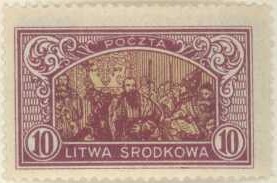
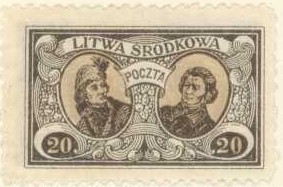
1 M grey and yellow 2 M red and green 3 M green 4 M brown (two shades) 5 M brown 6 M grey and brown 10 M lilac and brown 20 M brown (two shades)
Value of the stamps |
|||
vc = very common c = common * = not so common ** = uncommon |
*** = very uncommon R = rare RR = very rare RRR = extremely rare |
||
| Value | Unused | Used | Remarks |
| All values except 20 M | c | c | |
| 20 M | * | * | |
Forgeries exist of these stamps.
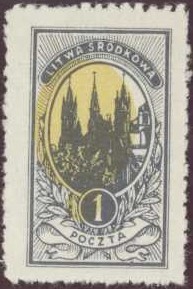
Possibly a forgery, the trees in the center are not that clear
and the lines in the background are not as regular as they should
be. See for example: http://www.filatelia.fi/forglinks/exhibit/page02.jpg
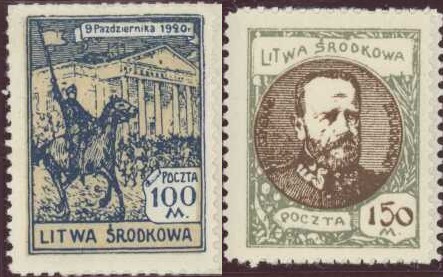
100 M blue and brown (general on a horse) 150 M olive and brown (portrait of the general)
Value of the stamps |
|||
vc = very common c = common * = not so common ** = uncommon |
*** = very uncommon R = rare RR = very rare RRR = extremely rare |
||
| Value | Unused | Used | Remarks |
| All values | ** | ** | |
10 M brown 25 M red and brown 50 M blue 75 M brown
Value of the stamps |
|||
vc = very common c = common * = not so common ** = uncommon |
*** = very uncommon R = rare RR = very rare RRR = extremely rare |
||
| Value | Unused | Used | Remarks |
| 10 M | * | * | |
| 25 M | * | * | |
| 50 M | * | * | |
| 75 M | ** | ** | |
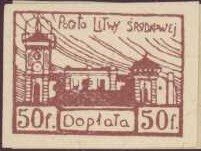

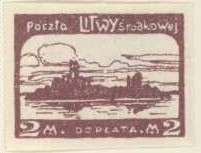
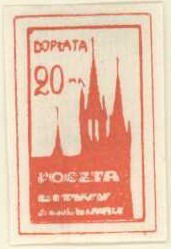
50 f brown 1 M green 2 M brown 3 M brown 5 M brown 20 M red
Value of the stamps |
|||
vc = very common c = common * = not so common ** = uncommon |
*** = very uncommon R = rare RR = very rare RRR = extremely rare |
||
| Value | Unused | Used | Remarks |
| 50 f to 3 M | c | c | |
| 5 M and 20 M | c | * | |
A forgery of the 50 f is described in Linn's Stamp News 1991 (12-16-1991) by Varro Tyler. It says this forgery is printed on brownish paper (genuine stamps on white paper). Genuine stamps have perforation 11 1/2 or are imperforate; the forgeries are perforated 10 1/2, 11 1/2, or imperforate. The design is almost identical.
http://members.fortunecity.com/jtckaptein/philatelyoflithuania/onaeng.htm
In 1920 the Memel territory (formerly belonging to Germany) was put under the influence of France. It joined Lithuania in 1923. For examples of these stamps see Cd 1.